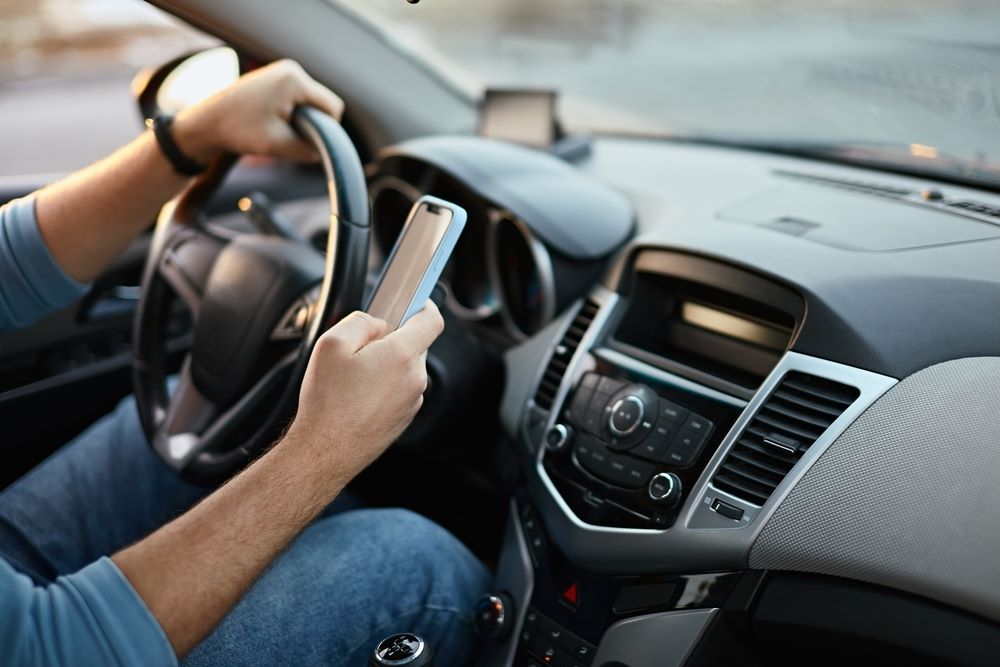Texting while operating a moving vehicle is strictly prohibited in Texas. Unfortunately, that doesn’t stop motorists from thinking they can get away with reading and replying to a quick text while on the road.
If a texting driver causes an accident and you’re injured as a result, you can pursue compensation.
But a successful personal injury claim relies on evidence, and proving a driver was texting during an accident can be challenging.
In this blog post, we explore the common defenses drivers might use and how to prove a driver was testing to support your compensation claim.
What Does Texas Law Say about Texting While Driving?
Cell phone laws vary by city, with some banning drivers from using their phones entirely, but wherever you are in the state, it is illegal to text while driving.
This law came into effect on September 1st, 2017 in response to the shocking statistic that one in five Texas crashes is caused by distracted driving.
Unfortunately, distracted driving — which includes texting — continues to be a prevalent cause of car accidents, as our 2023 Texas auto statistics show: 398 individuals were killed in accidents involving distracted driving.
While this blog is not about why so many individuals might use their cell phones at the wheel, it is perhaps telling that the penalties for texting while driving start at just $25 for a first offense. If a driver is found to have previously been convicted of texting while operating a vehicle, they can expect a fine of $100 to $200.
It is only when a driver’s conduct causes the death or serious bodily injury of another person that the crime becomes a Class A misdemeanor, punishable by a fine not to exceed $4,000 and jail time for up to one year.
But these penalties arguably pale in comparison to the potentially devastating consequences suffered by accident victims injured because of another driver’s decision to read or send a text or email when their eyes should be on the road.
A family might lose a loved one and struggle to pay for a funeral and provide for their family now they are the primary breadwinner, not to mention suffer immense grief and anguish. Others might sustain life-changing injuries, such as a traumatic brain injury (TBI) that requires lifelong treatment or a spinal cord injury that leaves them with a permanent disability.
Even a minor injury can leave a car accident victim unable to work for several months and needing costly medical treatment.
Car accident victims can recover these costs — called damages — and be compensated for additional losses they suffer as a result of their injuries, such as:
- Pain and suffering
- Mental anguish
- Loss of enjoyment.
However, they must prove their injuries resulted from the accident, and that the accident was caused by another’s negligence.
So, if you think another driver was texting while driving, causing them to be distracted and crash into you, how do you prove it?
How to Prove an At-Fault Driver Was Texting
Evidence is critical to recover the compensation you’re owed for your injuries. Your word alone that you suspect a driver was texting —or even if you saw them using their phone before the accident — is not enough.
Fortunately, several types of evidence can help prove your claim.
Phone Records
Phone records can support your claim by proving a driver was on their phone before the accident — including what they were doing. Texas law doesn’t specifically prohibit texting while driving — sending any “electronic message” is against the law, including reading or sending an email, replying to a WhatsApp message, or posting an update to Facebook. Cell phone records can show when a message was sent or received. Consider the following scenarios:
- Cell phone records show the driver received a text message 30 seconds before they crashed into you.
- Cell phone data shows the driver posted a social media update just moments before the accident.
- Cell phone records show the driver was using a messenger app during the crash, which shows an unsent message, indicating the driver was in the middle of typing a reply.
Cell phone records can significantly bolster your claim by demonstrating a driver’s negligence.
You must file a motion with the court to obtain cell phone records from the wireless phone provider. The driver will likely object, and the cell phone company will not hand over sensitive data willingly, so it’s advisable to consult a personal injury lawyer, who can secure the records and have them analyzed by a professional.
Drivers who were using their cell phone before a crash might delete incriminating call logs or messages after the fact to hide their conduct. However, this data can be recovered.
Cell phone records can be strong evidence. This data alone does not irrefutably prove a driver was texting, but it can be enough to satisfy the burden. The legal standard you must meet to recover compensation is “by a preponderance of the evidence”, meaning more likely than not, so a jury may have a reasonable doubt that the driver was using their phone just before the accident happened, but as long as the evidence suggests that they were more likely than not texting, you have a strong case for getting the compensation you are entitled to.
However, with additional evidence, you reduce the likelihood of a jury siding with the other driver or, if you’d prefer to settle without going to court, the less likely the other driver will “roll the dice” and take their chances at trial.
Talk to Eyewitnesses
Eyewitness testimony is not the strongest form of evidence; witnesses can be tricky to track down, and memories fade over time. People can also be dishonest or lack credibility, which can do more harm than having no witnesses at all. But eyewitness testimony can still be valuable. If cell phone records prove a driver received a text message before the crash but claims they were not on their phone, an eyewitness who saw them looking down would add credibility to your statement and dispute their other driver’s story.
You should ideally speak to witnesses as soon as possible after your accident to take their contact details. A car accident attorney can follow up with witnesses as they gather evidence for your personal injury claim.
Obtain Camera Footage
If there are cameras on the road where your accident occurred, your personal injury attorney might be able to obtain the footage to determine if it shows the driver in their vehicle. Traffic cams often capture footage, but CCTV footage from nearby offices, restaurants, stores, ATMs and doorbell cameras on residential streets can be a valuable source of evidence to prove a driver was texting. It can be helpful to make a list of nearby establishments to where you crashed and pass it to your lawyer, who will investigate whether there is footage from the time of your accident that supports your case.
Appoint an Accident Reconstructionist
Accident reconstructions are not always necessary to prove negligence in a car accident claim, but they can be helpful for particularly complex accidents involving multiple parties or when another driver disputes how you claim the accident happened.
An accident reconstructionist is an expert who will analyze the crash and use available data to recreate the conditions of the accident, from the weather conditions to the actions of individual drivers. Using physical and digital methods, a reconstructionist can create various scenarios and match the data to the available evidence. You can use the resulting report and reconstructionist’s testimony to show how the accident occurred and to refute the other driver’s story.
Get a Copy of the Accident Report
You must call the police immediately if you or anyone else is injured or killed in a car accident in Texas. When police arrive, they will investigate the accident, which involves speaking to those involved and any bystanders, documenting vehicle damage and injuries, and determining what factors contributed to the crash. The attending officer will compile their findings into a report, known as an accident report, crash report, or police report.
This report is vital evidence that can prove a driver was texting. If the police issue the other driver a citation for driving while distracted or note “Cell Phone Use – Texting” as a contributing factor in the report, it will be much easier to negotiate a settlement or secure a fair judgment if you take your personal injury claim to trial. Our San Antonio and McAllen accident attorney can help you secure an authorized copy of your crash report, help you interpret it, and challenge the report if it is not an accurate representation of what you told the police at the scene.
Proving driving while texting can be challenging, but our experienced personal injury attorney in McAllen and San Antonio can secure the outcome you deserve. We’ll explore your options, highlight how much you could be entitled to, gather evidence while you focus on your recovery, and fight to secure maximum compensation, whether through settlement negotiations or a jury trial.
We provide five-star-rated personal injury services in English and Spanish and serve the entire Rio Grande Valley and Greater San Antonio, from New Braunfels to Harlingen.
You don’t pay fees until we win. Call 855-LAW-NINJA to speak to our experienced McAllen and San Antonio car accident lawyer today.


